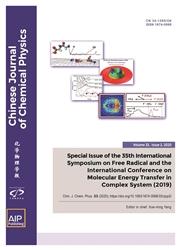CO/OH诱导贵金属纳米颗粒在TiO2(110)上崩解的第一性原理热力学研究
IF 1
4区 化学
Q4 PHYSICS, ATOMIC, MOLECULAR & CHEMICAL
引用次数: 0
摘要
揭示负载型金属纳米颗粒分解的基本机制及其对金属组分和反应物种类的依赖性,对于提高负载型金属纳米催化剂和单原子催化剂的稳定性至关重要。本研究利用基于第一性原理的分解热力学,研究了CO-和OH-诱导的Ag、Cu、Au、Ni、Pt、Rh、Ru和Ir纳米颗粒在TiO2(110)的原始氧空位和桥氧空位上分解成金属反应物配合物(M(CO)n、M(OH)n、n=1和2)。研究发现,与OH相比,CO与这些过渡金属的相互作用更强,导致地层能量更低,对纳米颗粒(NPs)的分解有更大的促进作用。相应的反应物吸附能与金属黏合能呈线性关系,黏合能越高的金属与反应物和载体的结合越强,其原子稳定性越高。进一步的分解自由能计算表明,只有co诱导的Ni, Rh, Ru和Ir纳米颗粒的分解在热力学上是可行的。这些结果提供了反应物诱导的金属纳米颗粒分解成热力学稳定的金属单原子催化剂的更深层次的理解。本文章由计算机程序翻译,如有差异,请以英文原文为准。
First-principles thermodynamics study of CO/OH induced disintegration of precious metal nanoparticles on TiO2(110)
Revealing the fundamental mechanisms governing reactant-induced disintegration of supported metal nanoparticles and their dependences on the metal component and reactant species is vital for improving the stability of supported metal nanocatalysts and single-atom catalysts. Here we use first-principles based disintegration thermodynamics to study the CO- and OH- induced disintegration of Ag, Cu, Au, Ni, Pt, Rh, Ru, and Ir nanoparticles into metal-reactant complexes (M(CO)n, M(OH)n, n=1 and 2) on the pristine and bridge oxygen vacancy site of TiO2(110). It was found that CO has a stronger interaction with these considered transition metals compared to OH, resulting in lower formation energy and a larger promotion effect on the disintegration of nanoparticles (NPs). The corresponding reactant adsorption energy shows a linear dependence on the metal cohesive energy, and metals with higher cohesive energies tend to have higher atomic stability due to their stronger binding with reactant and support. Further disintegration free energy calculations of NPs into metal-reactant complexes indicate only CO-induced disintegration of Ni, Rh, Ru, and Ir nanoparticles is thermodynamically feasible. These results provide a deeper understanding of reactant-induced disintegration of metal nanoparticles into thermodynamically stable metal single-atom catalysts.
求助全文
通过发布文献求助,成功后即可免费获取论文全文。
去求助
来源期刊

Chinese Journal of Chemical Physics
物理-物理:原子、分子和化学物理
CiteScore
1.90
自引率
10.00%
发文量
2763
审稿时长
3 months
期刊介绍:
Chinese Journal of Chemical Physics (CJCP) aims to bridge atomic and molecular level research in broad scope for disciplines in chemistry, physics, material science and life sciences, including the following:
Theoretical Methods, Algorithms, Statistical and Quantum Chemistry
Gas Phase Dynamics and Structure: Spectroscopy, Molecular Interactions, Scattering, Photochemistry
Condensed Phase Dynamics, Structure, and Thermodynamics: Spectroscopy, Reactions, and Relaxation Processes
Surfaces, Interfaces, Single Molecules, Materials and Nanosciences
Polymers, Biopolymers, and Complex Systems
Other related topics
 求助内容:
求助内容: 应助结果提醒方式:
应助结果提醒方式:


